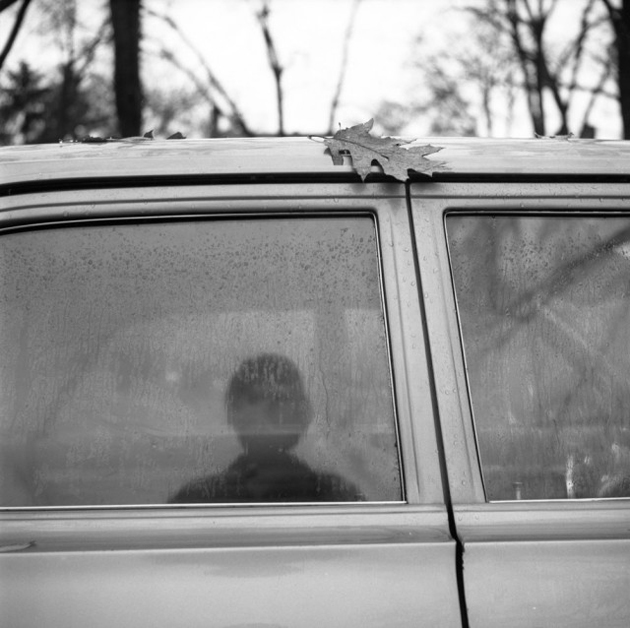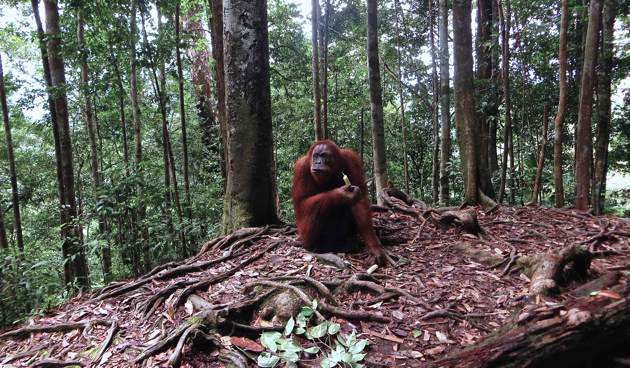Editors’ Favorites From 2014
The staff choose their most-liked pieces published in 2014: a painting expedition through the Underground Railroad, a personal memory of Vivian Maier, and a restaurant review that isn’t a restaurant review.

“Dear Daughter, Your Mom” by Sarah Smarsh
Angela Chen: I have a bad habit of skipping around when I read: last sentence first, pull-quote, maybe a few paragraphs in the middle, then back to the top. I loved Sarah Smarsh’s essay “Dear Daughter, Your Mom” because the last sentence made me pause and decide that I would read it properly instead of darting around. The first sentence is wonderful, too. And so is the story (about Kansas, academics, inequality, Hooters) and the questions (“What would I do for the most precious things on Earth?”).
“Blues on Wheels” by Jess Stoner
Meave Gallagher: It turns out being a contract USPS employee is insanely terrible. Jess Stoner fulfilled her childhood dream of becoming a mail carrier, but along with genuine joy of bringing people their mail, she encountered incompetent management, labor violations, cowed employees, vicious dogs—it was awful. And because of Congress’s endless budget slashing, we cannot expect the situation to improve anytime soon. As Stoner puts it, “There is no ‘It gets better’ for the people who work for the Post Office. And since I’ve quit, the conversations I’ve had with the employees at my former station only confirm my depressing conclusion.” The USPS was a revered institution, and our government has treated it like garbage for so long; its employees are terrorized, neglected, and abused, and even though they’re unionized, they have little recourse. Stoner so movingly chronicled their travails that after publication, she received hundreds of emails from current and former USPS employees whose experiences were as bad as hers, if not worse. It turns out they were looking for a voice, and Jess Stoner was it.

“Remnants of the Underground Railroad” and “Painting the President” by Ben Shattuck
Rosecrans Baldwin: I’ve always been interested in painting, and frequently I talk to some of the country’s great up-and-coming painters for TMN’s Galleries section. So I was excited when two stories arrived unexpectedly from writer/painter Ben Shattuck this year.
The first one, “Remnants of the Underground Railroad,” published back in June, follows Ben while he tries to paint any remaining evidence of the Underground Railroad in Iowa. John Brown trained men in Iowa for his attack on Harper’s Ferry. Ben writes, “There’s something about Iowa’s farmhouses, so far apart to make room for the vast cornfields, that makes me think isolation is embedded in the land.”
The story from there is interesting from both an artistic and historical perspective—how do we preserve history, and which tools are best?
In the second article, published earlier this month, “Painting the President,” Ben sits down with portraitist Robert Anderson, who twice painted official portraits of President George W. Bush.
Anderson turns out to be a terrific interview subject, and the conversation between the two painters was luminous on a number of subjects—art, politics, legacy. I was surprised to hear about the president’s awareness of his signature smirk (which apparently he can’t control very well) and how it affects his public image. I thought my views on Bush were pretty firm, but the article made me see the 43rd president in a whole new light, not to mention presidential portraits.
“Thoroughly Modern Marxism” by Lucy Morris
Melissa Batchelor Warnke: 2014 was a terrible year for humanity, and a very good year for nonfiction writing. Perhaps my strongest impression of “Thoroughly Modern Marxism” all these months later is how it offered a completely clear, never withholding view of the author’s family life; relationship with money, Russia, and New York City; and privilege. And yet, at the piece’s end, I felt an exquisite openness—a sense that, powerful as it was on first read, there was something more to be learned from the writing, were I to offer it the time and attention. “Thoroughly Modern Marxism” is perceptive, demanding, dreamy, unusual; I loved it.

“Private Eye” by Edward McClelland
Bridget Fitzgerald: Along with the rest of the internet, I enjoyed the discovery a few years ago of an unknown photographer who had roamed the streets of Chicago in the ’50s and ’60s. Vivian Maier’s photos were fascinating for their old-fashioned (yet Storage Wars-appropriate) reveal: a box of old negatives bought at a storage auction. But Edward McClelland’s piece shines new light on who Vivian Maier really was—in the later years of her life, she was the bag lady of his neighborhood, who everyone knew but no one knew. He writes, “We’re both neighbors and strangers, most of us. In some ways, Vivian was less of a stranger because she was so strange.” It’s a lovely, familiar, bittersweet account that brought the author closer to his other unknown neighbors, and to that mysterious neighborhood character we can all recognize.
“Happiness Is a Pink Gun” by Alice Bolin and “Big Water” by Nathan Hegedus
Sam Stecklow: One of my favorite things is discovering new and fascinating things about subjects that before, I had no real interest in. Alice Bolin’s funny and thoroughly entertaining essay about Dolly Parton, Miranda Lambert, and female country singers in general fits this perfectly. Country music didn’t and still doesn’t have any real hold on me, but the politics and relationships between artists outlined by Bolin here are compelling to even the most Yankee among us.
On the other hand, a subject that is intrinsically interesting to me is Northern California, where I spent the last nine years of my life before deciding to schlep out to Chicago. (Why?) Nathan Hegedus’s excellent report on the wine country’s water system, the politics of it, and the state it is in after years of brutal, unending drought, is wonderfully written and reported. It’s also one of the saddest things I’ve read in recent memory; my old home is dying, sooner rather than later.
“Send, Dad” by Leah Finnegan, “Watch and Learn” by Graham T. Beck, and “Grandpa” by Patrick Ambrose
Nozlee Samadzadeh: This year, my favorite pieces were all about family. Leah Finnegan wrote about growing closer to her dad not by spending quality time together or initiating some kind of heart-to-heart, but quietly and in short bursts, by exchanging text messages with him. (Happily, she has continued to document these interactions via her Instagram.) Graham Beck learned how to slaughter a chicken, listen more empathetically to his wife, and, just maybe, stop bickering with his sister on car trips, all by watching YouTube videos. And starting with a ghostly visitation from his teetotaling grandmother, Patrick Ambrose revisits a long-ago summer spent with his grandparents and great uncle in rural North Carolina. Blood is thicker than water, and these heavy-hitting pieces prove it.

“Queen of the Jungle” by M. Myers Griffith
Nikkitha Bakshani: “It’s a wonder that orangutans resist attacking humans every time they encounter them,” Griffith writes, talking of how humans murder up to 3,882 orangutans a year—an outrageous amount, considering they are nearing extinction—yet orangutans hardly ever attack humans. This is an article about Mina, one very violent orangutan, and the power she has over her stretch of the jungle. I was drawn to the article because I think orangutans, like other great apes that share about 95 percent of our DNA, are fascinating, but what kept me reading was how well the personality—if we can call it that—of Mina is rendered. The article is part adventure tale, part anthropology lesson, part environmental warning, and part philosophical rumination on survival. For me it was a few minutes of 2014 very well spent.
“After Birth” by Jennifer Liss
Karolle Rabarison: After a no-fuss birth in the comfort of her home, Jennifer Liss faced an unexpected task: Do something with the placenta. “After Birth” is the candid, hilarious tale of a new mother’s experience with DIY medical waste disposal. Our writer opts for none of the options an internet search for “what to do with placenta” offers—including stuffed animals, skin-care products, and fruit smoothies, to name a few. Nor does she follow the midwife’s suggestion to “dig a deep, deep hole” in the hills and bury it there. I won’t say more so as not to risk spoiling the story. You must read it! Laugh and cringe along with the narrator. And then scroll to the top and immediately read the whole thing again.
“Chrissy Smoked” by Seth Sawyers
Emma Winsor Wood: I could read a series of beautiful, but narratively disconnected, sentences forever; Sawyers’s elegiac essay for an old friend, however, manages to maintain sentence-by-sentence loveliness while also weaving a taut, and moving, narrative. It is rare to read about male friendships, particularly of the hard-drinking, blue-collar type described here, and I was grateful for the chance to look in on some of their most intimate moments.
“What Doesn’t Kill You Doesn’t Kill You” by Karen Benning and “An Unthinkably Modern Miracle” by John Fischer
Liz Entman: Karen Benning’s account of visiting an Alaska bear sanctuary in order to confront her ursaphobia is a terrific lunch-break vacation. Her fear, which she details with great insight and humor, is as much a supporting character as the (really very interesting) bears and people she meets during her visit. I will never forget her image of a large, redheaded Viking of a park ranger strolling through the woods shouting, “Here, kitty, kitty, kitty” to keep the bears away.
It’s hard to decide which is more discomfiting in “An Unthinkably Modern Miracle”: undergoing urological surgery or trying to make sense of the bill afterward. Fischer deserves high praise for describing both an excruciatingly intimate medical procedure and the failings of the modern healthcare system with equal clarity, wit, and grace.
“Radio Maria” by Roxane Gay
Hayden Higgins: The first lesson I learned in anthropology was: A family is a group of people that dines together. In Roxane Gay’s review of Radio Maria, a Spanish restaurant in Champaign-Urbana, Ill., she enumerates the coterie of concerns—germophobia, the solitude of constant travel, her perfectionism—that follow her to every table. She’s introducing us to the family in her own head.
If the essay is a conversation between members of a mental family, this review is a convivial argument about traveling, about being alone, about the constant push and pull between wanting to control it all and wanting to abdicate every single responsibility. And she does this while writing about tortas. That is her gift—Roxane names her drives and compulsions with honesty, sits down to converse with them, and invites every reader to join.
